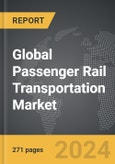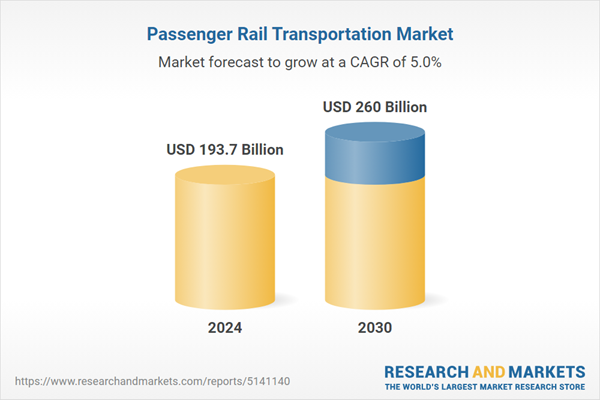The global market for Passenger Rail Transportation was valued at US$193.7 Billion in 2024 and is projected to reach US$260.0 Billion by 2030, growing at a CAGR of 5.0% from 2024 to 2030. This comprehensive report provides an in-depth analysis of market trends, drivers, and forecasts, helping you make informed business decisions. The report includes the most recent global tariff developments and how they impact the Passenger Rail Transportation market.
Segments: Distance (Long Distance Transport, Short Distance Transport).
Geographic Regions/Countries: World; United States; Canada; Japan; China; Europe (France; Germany; Italy; United Kingdom; Spain; Russia; and Rest of Europe); Asia-Pacific (Australia; India; South Korea; and Rest of Asia-Pacific); Latin America (Argentina; Brazil; Mexico; and Rest of Latin America); Middle East (Iran; Israel; Saudi Arabia; United Arab Emirates; and Rest of Middle East); and Africa.
The analysts continuously track trade developments worldwide, drawing insights from leading global economists and over 200 industry and policy institutions, including think tanks, trade organizations, and national economic advisory bodies. This intelligence is integrated into forecasting models to provide timely, data-driven analysis of emerging risks and opportunities.
Global Passenger Rail Transportation Market - Key Trends & Drivers Summarized
Why Is Passenger Rail Transportation Crucial for Modern Mobility?
Passenger rail transportation remains a cornerstone of public transit systems around the world, offering efficient, sustainable, and cost-effective mobility solutions for urban, suburban, and long-distance travel. With increasing urbanization and the rising demand for environmentally friendly transport options, rail systems are becoming essential for reducing traffic congestion and minimizing carbon emissions. High-speed rail, in particular, is revolutionizing long-distance travel by offering fast, reliable alternatives to air travel. As governments invest in modernizing rail infrastructure, enhancing connectivity, and improving passenger comfort, rail transportation is experiencing a resurgence as a preferred mode of travel for both daily commutes and intercity journeys.How Are Technological Advancements Revolutionizing Passenger Rail Systems?
Technological advancements are transforming passenger rail transportation, improving efficiency, safety, and passenger experience. Innovations such as autonomous trains, digital signaling systems, and real-time tracking are optimizing rail operations, reducing delays, and increasing the capacity of existing networks. Smart ticketing solutions and mobile apps are streamlining the passenger experience by offering contactless payments, seat reservations, and personalized travel updates. Additionally, the development of magnetic levitation (maglev) and hyperloop technologies is pushing the boundaries of high-speed rail, promising faster and more energy-efficient travel over long distances. These technologies are making rail systems more competitive with other modes of transportation, attracting more passengers to rail travel.What Are the Environmental and Economic Benefits of Passenger Rail Transportation?
Passenger rail transportation offers significant environmental and economic benefits compared to road and air travel. Trains are far more energy-efficient, emitting fewer greenhouse gases per passenger mile than cars or planes, making them a key component of sustainable urban planning. Rail systems also alleviate road congestion, reducing the economic costs associated with traffic delays, accidents, and road maintenance. Additionally, passenger rail networks contribute to economic development by improving regional connectivity, facilitating business travel, and supporting tourism. As cities and regions look to reduce their carbon footprint and enhance mobility, rail transportation is emerging as a vital part of the solution.The Growth in the Passenger Rail Transportation Market Is Driven by Several Factors
The growth in the passenger rail transportation market is driven by several factors, including increasing urbanization and the rising demand for sustainable and efficient transportation solutions. Technological innovations, such as autonomous trains, digital ticketing systems, and high-speed rail technologies, are enhancing the safety, reliability, and convenience of rail travel. Government investments in rail infrastructure, along with public policies promoting public transit and reducing carbon emissions, are further supporting the expansion of rail networks. Additionally, the growing environmental consciousness of passengers, who are seeking greener alternatives to road and air travel, is boosting demand for rail transportation. The economic benefits of rail systems, including reduced congestion and regional development, are also key drivers of market growth.Report Scope
The report analyzes the Passenger Rail Transportation market, presented in terms of units. The analysis covers the key segments and geographic regions outlined below.Segments: Distance (Long Distance Transport, Short Distance Transport).
Geographic Regions/Countries: World; United States; Canada; Japan; China; Europe (France; Germany; Italy; United Kingdom; Spain; Russia; and Rest of Europe); Asia-Pacific (Australia; India; South Korea; and Rest of Asia-Pacific); Latin America (Argentina; Brazil; Mexico; and Rest of Latin America); Middle East (Iran; Israel; Saudi Arabia; United Arab Emirates; and Rest of Middle East); and Africa.
Key Insights:
- Market Growth: Understand the significant growth trajectory of the Long Distance Transport segment, which is expected to reach US$142.3 Billion by 2030 with a CAGR of a 5.3%. The Short Distance Transport segment is also set to grow at 4.7% CAGR over the analysis period.
- Regional Analysis: Gain insights into the U.S. market, valued at $51.5 Billion in 2024, and China, forecasted to grow at an impressive 8.1% CAGR to reach $56.9 Billion by 2030. Discover growth trends in other key regions, including Japan, Canada, Germany, and the Asia-Pacific.
Why You Should Buy This Report:
- Detailed Market Analysis: Access a thorough analysis of the Global Passenger Rail Transportation Market, covering all major geographic regions and market segments.
- Competitive Insights: Get an overview of the competitive landscape, including the market presence of major players across different geographies.
- Future Trends and Drivers: Understand the key trends and drivers shaping the future of the Global Passenger Rail Transportation Market.
- Actionable Insights: Benefit from actionable insights that can help you identify new revenue opportunities and make strategic business decisions.
Key Questions Answered:
- How is the Global Passenger Rail Transportation Market expected to evolve by 2030?
- What are the main drivers and restraints affecting the market?
- Which market segments will grow the most over the forecast period?
- How will market shares for different regions and segments change by 2030?
- Who are the leading players in the market, and what are their prospects?
Report Features:
- Comprehensive Market Data: Independent analysis of annual sales and market forecasts in US$ Million from 2024 to 2030.
- In-Depth Regional Analysis: Detailed insights into key markets, including the U.S., China, Japan, Canada, Europe, Asia-Pacific, Latin America, Middle East, and Africa.
- Company Profiles: Coverage of players such as Administrator of Railway Infrastructures (ADIF), Alliance Global Group, Inc., Canadian Pacific, China Railway Corporation, Construcciones y Auxiliar de Ferrocarriles (CFA), S.A. and more.
- Complimentary Updates: Receive free report updates for one year to keep you informed of the latest market developments.
Some of the 38 companies featured in this Passenger Rail Transportation market report include:
- Administrator of Railway Infrastructures (ADIF)
- Alliance Global Group, Inc.
- Canadian Pacific
- China Railway Corporation
- Construcciones y Auxiliar de Ferrocarriles (CFA), S.A.
- Coras Iompair Eireann
- CrossCountry Trains
- CRRC Corporation Limited
- Delhi Metro Rail Corporation
- Deuta-Werke GmbH
Tariff Impact Analysis: Key Insights for 2025
Global tariff negotiations across 180+ countries are reshaping supply chains, costs, and competitiveness. This report reflects the latest developments as of April 2025 and incorporates forward-looking insights into the market outlook.The analysts continuously track trade developments worldwide, drawing insights from leading global economists and over 200 industry and policy institutions, including think tanks, trade organizations, and national economic advisory bodies. This intelligence is integrated into forecasting models to provide timely, data-driven analysis of emerging risks and opportunities.
What’s Included in This Edition:
- Tariff-adjusted market forecasts by region and segment
- Analysis of cost and supply chain implications by sourcing and trade exposure
- Strategic insights into geographic shifts
Buyers receive a free July 2025 update with:
- Finalized tariff impacts and new trade agreement effects
- Updated projections reflecting global sourcing and cost shifts
- Expanded country-specific coverage across the industry
Table of Contents
I. METHODOLOGYII. EXECUTIVE SUMMARY2. FOCUS ON SELECT PLAYERSIII. MARKET ANALYSISIV. COMPETITION
1. MARKET OVERVIEW
3. MARKET TRENDS & DRIVERS
4. GLOBAL MARKET PERSPECTIVE
UNITED STATES
CANADA
JAPAN
CHINA
EUROPE
FRANCE
GERMANY
ITALY
UNITED KINGDOM
SPAIN
RUSSIA
REST OF EUROPE
ASIA-PACIFIC
AUSTRALIA
INDIA
SOUTH KOREA
REST OF ASIA-PACIFIC
LATIN AMERICA
ARGENTINA
BRAZIL
MEXICO
REST OF LATIN AMERICA
MIDDLE EAST
IRAN
ISRAEL
SAUDI ARABIA
UNITED ARAB EMIRATES
REST OF MIDDLE EAST
AFRICA
Companies Mentioned (Partial List)
A selection of companies mentioned in this report includes, but is not limited to:
- Administrator of Railway Infrastructures (ADIF)
- Alliance Global Group, Inc.
- Canadian Pacific
- China Railway Corporation
- Construcciones y Auxiliar de Ferrocarriles (CFA), S.A.
- Coras Iompair Eireann
- CrossCountry Trains
- CRRC Corporation Limited
- Delhi Metro Rail Corporation
- Deuta-Werke GmbH
Table Information
| Report Attribute | Details |
|---|---|
| No. of Pages | 271 |
| Published | April 2025 |
| Forecast Period | 2024 - 2030 |
| Estimated Market Value ( USD | $ 193.7 Billion |
| Forecasted Market Value ( USD | $ 260 Billion |
| Compound Annual Growth Rate | 5.0% |
| Regions Covered | Global |









